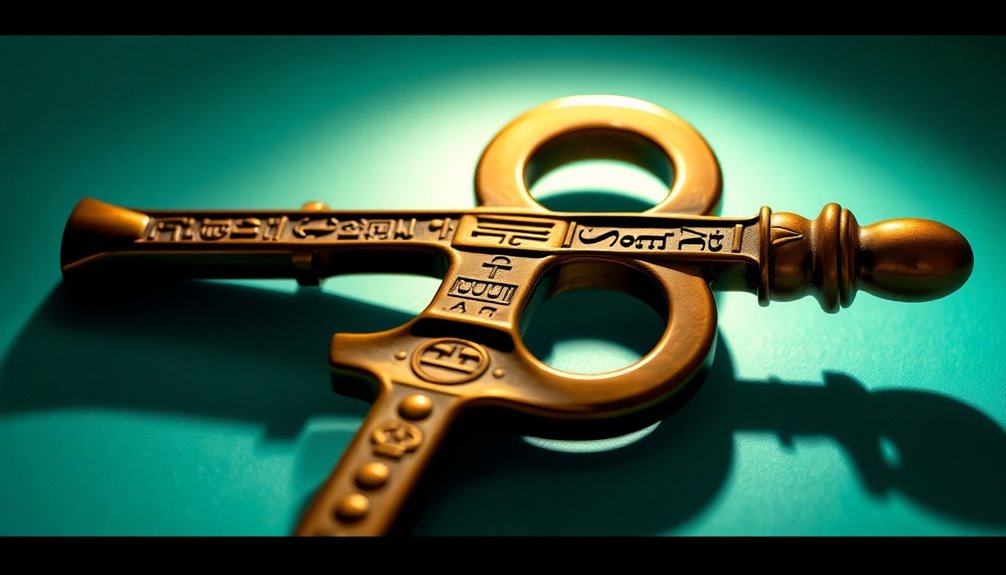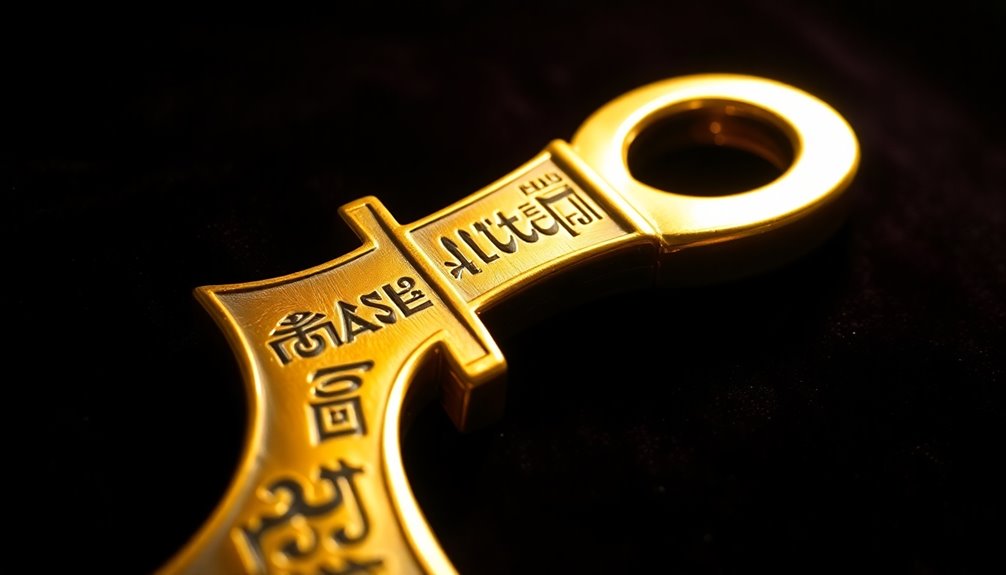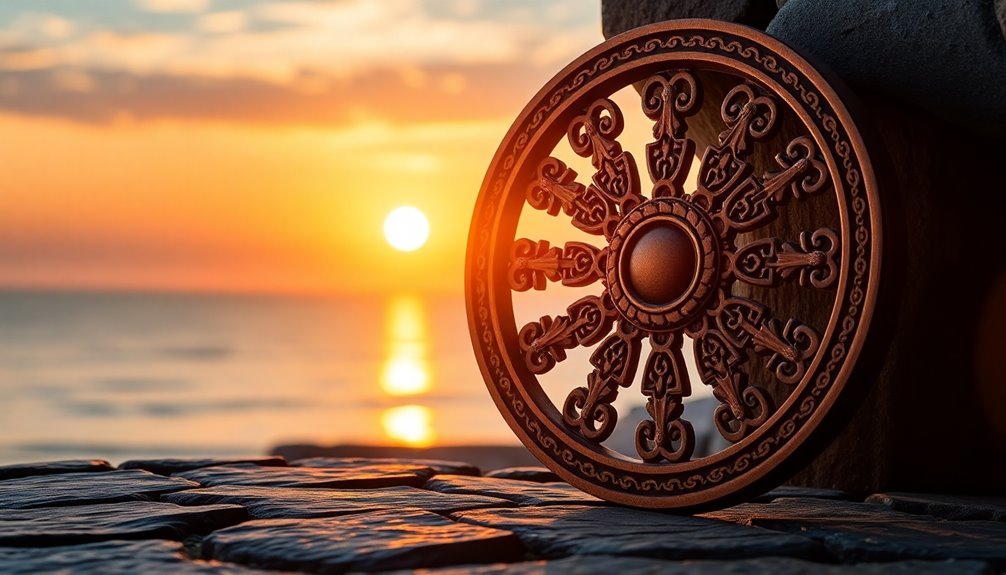The original Egyptian ankh is more than just a symbol; it embodies the ancient quest for eternal life. Dating back to around 4000 BC, this iconic shape represents life, divinity, and the afterlife, closely linked to deities like Osiris and Isis. Its loop signifies eternity, while the T-shape stands for life itself. The ankh was often featured in tombs and rituals, emphasizing its role in resurrection beliefs. Today, it still inspires modern spirituality and fashion. If you're curious about its rich meanings and cultural significance, you might uncover even more fascinating insights.
Key Takeaways
- The ankh symbolizes eternal life and is deeply rooted in ancient Egyptian beliefs about resurrection and the afterlife.
- Represented in art and rituals, the ankh embodies the divine connection between mortals and the eternal.
- Associated with deities like Osiris and Anubis, the ankh signifies their power over life and the afterlife.
- Ankh-shaped amulets were believed to offer protection and ensure safe passage to the afterlife for the deceased.
- The symbol's modern interpretations continue to celebrate themes of immortality and spirituality across cultures.
Origins of the Ankh

The ankh, often recognized for its distinctive cross shape topped with a loop, traces its origins back to ancient Egypt around 4000 BC.
This remarkable symbol likely evolved from early illustrations of sandal straps or knot forms, with its first known appearances dating to the First Dynasty (30th-29th century BC).
As you explore the rich tapestry of ancient Egyptian civilization, you'll notice that the ankh frequently appeared in artwork, often depicted in the hands of deities, reinforcing its connection to life and resurrection.
Symbolism and Meaning

The ankh connects life and immortality, embodying the belief in an eternal life force.
It represents divine power, often seen in the hands of deities and pharaohs, symbolizing their ability to give life and fertility.
Throughout history, this iconic symbol has maintained its cultural significance, resonating with modern spiritual practices and beliefs.
Life and Immortality Connection
Ankh symbolism intertwines life and immortality, representing a profound connection that resonates deeply within ancient Egyptian culture. The ankh symbolizes eternal life, with its distinctive loop embodying a continuous cycle without beginning or end.
When you see deities like Isis and Osiris holding the ankh, it illustrates their life-giving powers and their intimate links to resurrection and immortality. This powerful symbol wasn't just for the gods; it was believed to grant the bearer the qualities of life and protection.
Many people wore the ankh as an amulet, seeking blessings and good fortune throughout their lives. In funerary practices, the ankh played a critical role, used in rituals designed to guarantee safe passage to the afterlife. This reinforced its status as a key to immortality.
The design of the ankh merges male and female energies, with the T-shape representing life and the loop signifying eternity. This balance of existence highlights the interconnectedness of life and death in ancient Egyptian belief, reminding you that eternal life isn't just a destination but a continuous journey.
Divine Power Representation
Symbolizing divine power, the ankh reflects the profound authority of ancient Egyptian deities over life and death. This iconic symbol, often seen in the hands of gods like Isis and Anubis, conveys their ability to grant life and sustain souls in the afterlife. The ankh's unique design—a T-shaped cross topped with a loop—embodies the union of male and female energies, emphasizing the continuity of life.
- The ankh was originally reserved for pharaohs, signifying their divine power and connection to the gods.
- It served as a powerful emblem in tomb art, offering hope for eternal life after death.
- As a representation of the life force, the ankh bridged the physical and spiritual domains.
In its various depictions, the ankh signifies not just immortality but also the divine power that governs existence itself. Its presence in ancient rituals and artifacts underscores its importance in connecting humanity with the divine, reminding us of the eternal cycle of life and the everlasting influence of the gods.
The ankh remains a potent symbol of hope and spiritual continuity, transcending time and culture.
Cultural Significance Throughout History
Throughout history, the ankh has held profound cultural significance as a powerful symbol of eternal life. Dating back to at least 4000 BC, it was closely associated with the goddess Isis, representing fertility, motherhood, and the life force that permeates existence.
This symbol of life, with its distinctive T-shape and loop, embodies both male and female energies, reflecting the balance of creation. In ancient Egyptian art, you often see deities clutching the ankh, emphasizing their role as life-givers. Pharaohs, too, frequently carried the ankh, showcasing their authority and connection to the divine.
It played a vital role in funerary rites, symbolizing hope for a safe passage into the afterlife. The ankh's influence didn't stop in Egypt; it reached neighboring cultures and even appeared in early Christian iconography as a symbol of life and resurrection.
This enduring legacy highlights the ankh's significance, reminding us that the quest for eternal life transcends time and culture. As you explore its rich history, consider how the ankh continues to resonate as a universal symbol of life and the human desire for immortality.
Ankh in Ancient Egyptian Culture
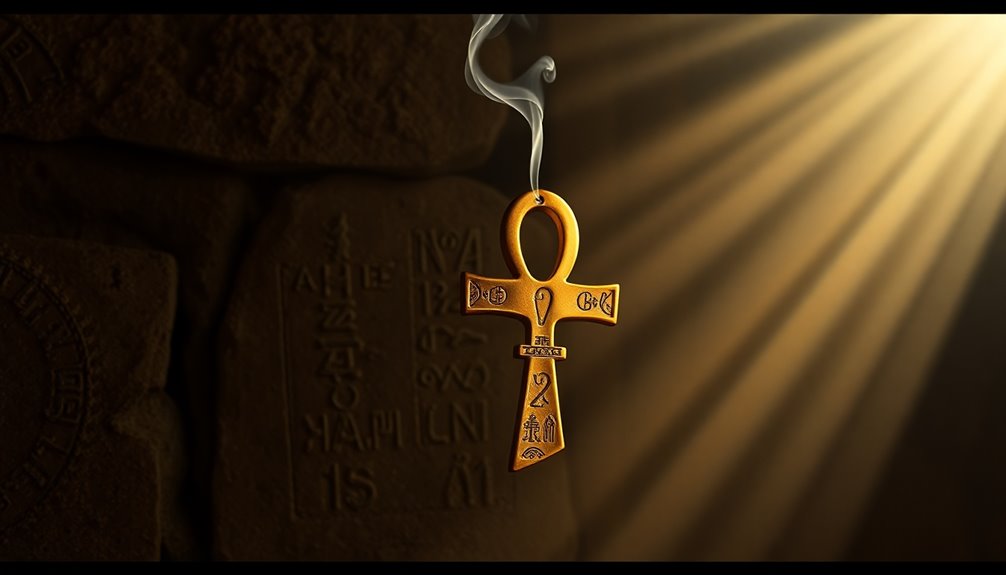
The ankh isn't just a pretty symbol; it represents eternal life and the beliefs surrounding it in ancient Egyptian culture.
You'll find it prominently in rituals and art, reflecting the society's deep connection to the afterlife.
This enduring symbol also played a key role in how Egyptians viewed their gods and the protection they sought for themselves.
Symbol of Eternal Life
If you've ever come across the ankh, you've likely noticed its powerful shape and rich meaning in ancient Egyptian culture. This iconic symbol represents eternal life and has been revered for thousands of years.
You can often see the ankh held by gods and pharaohs, signifying their divine power to bestow life. Its unique design—a cross with a loop—embodies the union of male and female energies, emphasizing both life and eternity.
Here are some fascinating aspects of the ankh:
- Early representations date back to around 4000 BC, featuring prominently in tomb paintings.
- The ankh was closely associated with the goddess Isis, symbolizing fertility and motherhood.
- It served as a protective amulet, believed to bring good fortune to the wearer.
The ankh's significance transcends ancient times, remaining an essential symbol in religious practices and artistic expressions.
It solidifies its role as a key icon of life within Egyptian mythology, embodying the hope for eternal life after death. When you see the ankh, you're witnessing a timeless representation of the quest for immortality.
Rituals and Afterlife Beliefs
Embodying the essence of life and death, the ankh played an important role in ancient Egyptian rituals and beliefs about the afterlife. This powerful symbol represented the life force and was frequently depicted in tomb paintings, showcasing the hope for eternal life beyond death.
You'd often find it held by gods in artwork, highlighting their life-giving power, especially during funerary rites for pharaohs and their subjects. The ankh was believed to possess protective qualities, commonly used in amulets to guarantee safe passage to the afterlife for the deceased.
Rituals involving the ankh included offerings and prayers directed to the gods, invoking their favor for the rejuvenation of the soul in the afterlife. Its connection with the goddess Isis emphasized themes of fertility and resurrection, further solidifying its significance in rituals related to life, death, and rebirth.
In these sacred practices, the ankh represented not just a symbol, but a crucial link between the mortal world and the eternal. Through rituals centered on this emblem, ancient Egyptians sought to secure a favorable afterlife, guaranteeing their legacy lived on through the ages.
The Ankh and Deities

In ancient Egyptian mythology, the ankh serves as a powerful symbol of life and divinity, often found in the hands of key deities. You'll notice that these ancient Egyptian deities hold the ankh as a sign of their authority and their role in sustaining life and guiding souls.
- Goddess Isis: Frequently depicted with the ankh, she embodies fertility and motherhood, showcasing her crucial role in bestowing life and protection.
- Anubis: The god of the afterlife is illustrated revitalizing souls with the ankh, emphasizing its importance in resurrection and the judgment of the dead.
- Osiris: Often shown holding an ankh, he reinforces its symbolism of eternal life, making it essential in the cycle of death and rebirth.
Maat, the goddess of truth and order, also holds the ankh, representing the balance and harmony necessary for life.
This divine connection between the ankh and ancient Egyptian deities highlights its significance, not just as a symbol, but as a key to understanding their beliefs about life, death, and the afterlife.
The Ankh in Art and Architecture

The ankh's significance extends beyond its association with deities; it also plays an essential role in ancient Egyptian art and architecture. You'll often see the ankh depicted in various forms, held by gods and pharaohs, symbolizing their divine power and connection to eternal life.
In the grand temples and elaborate tombs of ancient Egypt, the ankh motif was meticulously incorporated into designs, reinforcing its importance in both religious and funerary contexts.
In funerary art, the ankh frequently appears in ancient Egyptian hieroglyphic inscriptions, representing life and resurrection. This symbol also found its way into tangible objects like ankh-shaped mirrors, believed to reflect the beauty of the afterlife. These mirrors were commonly placed in royal tombs, showcasing the ankh's dual role in beauty and spirituality.
Today, the legacy of the ankh persists in modern artistic interpretations through sculptures, jewelry, and tattoos. Its enduring presence speaks to the rich cultural significance the ankh holds, bridging ancient beliefs with contemporary expressions of identity and spirituality.
In this way, the ankh continues to resonate, symbolizing life's perpetual cycle.
Ankh's Role in the Afterlife

Throughout ancient Egyptian culture, the ankh stood as a powerful symbol of the afterlife, representing hope and the promise of eternal existence. You'd find the ankh depicted in tomb paintings, reminding the deceased of their journey beyond death. This sacred symbol wasn't just art; it was a lifeline to the afterlife.
- Gods often held the ankh, signifying their divine role in granting life and protection to pharaohs and departed souls.
- Amulets shaped like the ankh were carefully placed in tombs, ensuring safe passage and revival for the deceased.
- Funerary rites incorporated the ankh, embodying beliefs in resurrection and the continuity of life beyond death.
Rituals involving the ankh invoked the life-giving powers of deities, reinforcing its significance in the cycle of life, death, and rebirth.
Modern Interpretations and Uses
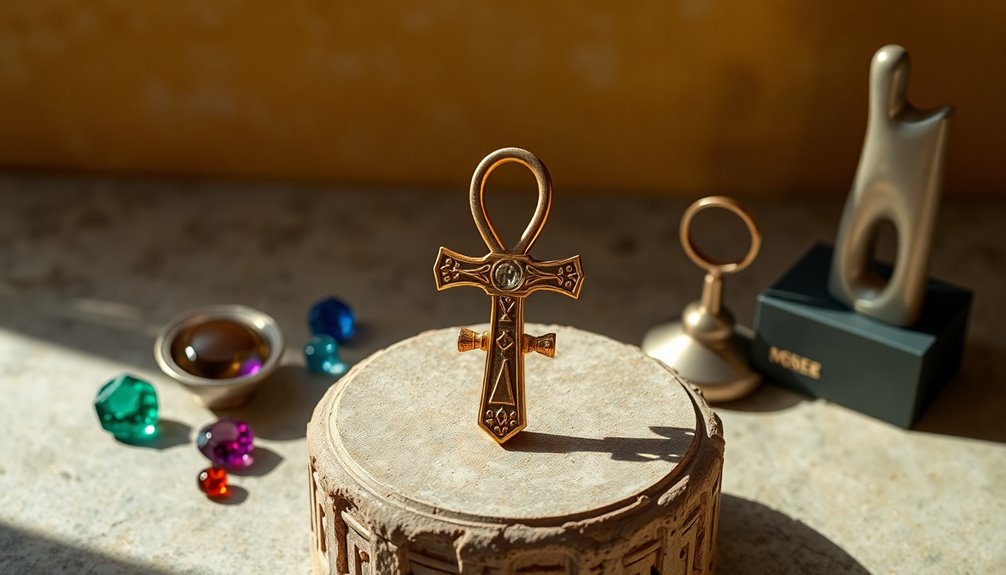
Today, the ankh symbolizes more than just ancient beliefs; it's a vibrant emblem in modern culture. You'll find the ankh making its way into contemporary fashion, often seen in jewelry and tattoos that express life and spirituality.
As you explore modern spiritual practices, you'll notice the ankh's strong connection to Kemetism, where it embodies ancient wisdom and the life force.
Various subcultures, particularly the goth community, embrace the ankh for its themes of immortality and the supernatural, reflecting a deep fascination with life beyond death.
Artists and designers frequently incorporate the ankh into their work, utilizing its rich symbolism to spark conversations about existence, mortality, and the afterlife.
You might even spot the ankh in popular media, including films, television series, and literature, reinforcing its status as a cultural icon representing eternal life.
This modern interpretation of the ankh keeps it alive and relevant, allowing you to connect with its history while exploring its significance in today's world.
Whether you wear it or admire it in art, the ankh continues to inspire and provoke thought about the mysteries of life.
The Ankh in Popular Culture

In popular culture, the ankh stands out as a powerful symbol of life and spirituality, enchanting audiences across various mediums. Since the 1960s, it's become a popular motif in jewelry and fashion, often worn to express a connection to deeper meanings. Its adoption goes beyond mere aesthetics; the ankh resonates with themes of immortality and the afterlife, particularly within the goth subculture and vampire-themed narratives.
Consider these aspects of the ankh's impact:
- It symbolizes a connection to ancestral heritage in Kemetism, a modern movement reviving ancient Egyptian beliefs.
- Various artists and designers incorporate the ankh into tattoos and modern art, showcasing ancient wisdom and cultural identity.
- The ankh has transcended its original cultural context, influencing artistic expressions globally, representing life and eternal existence.
As you engage with these interpretations, it's clear the ankh serves as a reminder of our quest for understanding life and its mysteries. Additionally, the ankh's significance aligns with the concept of spiritual energy, reflecting the essence of consciousness and our connection to the universe.
Its presence in contemporary culture illustrates how ancient symbols can evolve, maintaining relevance in a modern context while honoring their rich history.
Continuing Legacy of the Ankh
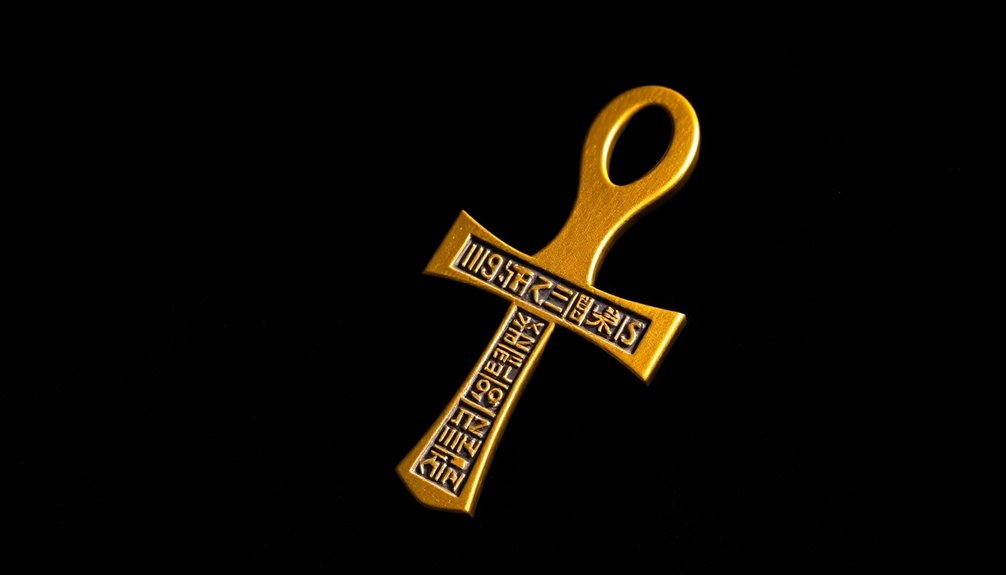
As the ankh continues to evolve, its enduring legacy captivates people across diverse cultures and spiritual practices. This ancient symbol has transcended its Egyptian origins, becoming synonymous with life and spirituality. You'll find the ankh prominently featured in jewelry and tattoos since the 1960s, making it a cherished emblem for those seeking a connection to eternal life.
Moreover, the ankh plays a pivotal role in contemporary movements like Kemetism, which aims to revive ancient Egyptian beliefs. Its imagery also weaves through art and design globally, influencing everything from Minoan artifacts to Anatolian hieroglyphs. As you explore modern interpretations, you'll see the ankh often highlighted in artistic expressions that emphasize eternal life and ancient wisdom.
| Aspect | Description |
|---|---|
| Symbolism | Represents eternal life and spirituality |
| Cultural Influence | Seen in Kemetism and various art forms |
| Historical Roots | Originated in ancient Egypt |
| Modern Usage | Popular in jewelry, tattoos, and art |
| Artistic Interpretations | Emphasizes connection to ancient wisdom |
This ongoing fascination with the ankh reflects a deep-rooted appreciation for ancient Egyptian beliefs about life and the afterlife.
Frequently Asked Questions
Why Is the Ankh Called the Key of Life?
The ankh's called the "Key of Life" because it symbolizes eternal life and the life-giving powers of ancient Egyptian deities.
When you look at its unique design, combining a cross and a loop, you see it represents both male and female energies, embodying the essence of life.
Often depicted in the hands of gods and pharaohs, it signifies their authority to grant life and secure safe passage to the afterlife.
What Does the Bible Say About Ankh?
When it comes to the ankh, you might find yourself barking up the wrong tree if you look for biblical references. The Bible doesn't mention it directly, as it's rooted in ancient Egyptian beliefs about eternal life.
However, themes of resurrection and everlasting life resonate in scripture, particularly in John 3:16. While the ankh symbolizes eternity, the Bible focuses on salvation through faith in Jesus, offering a different perspective on life after death.
What Is the Egyptian Symbol for Eternity?
The Egyptian symbol for eternity is the ankh. This iconic design features a T-shape topped with a loop, representing life and the eternal cycle.
You'll often see it in ancient art, held by deities like Isis and Osiris, signifying their ability to grant eternal life.
The ankh embodies the concept of endlessness, influencing modern interpretations of spirituality and appearing in various forms like jewelry and tattoos, celebrating life and immortality.
What Is the Power of the Egyptian Ankh?
Have you ever wondered what it feels like to hold the power of life in your hands?
The Egyptian ankh embodies immense significance, symbolizing eternal life and the continuity of existence. When you see it, you recognize its association with deities like Isis and Osiris, reflecting fertility and resurrection.
Worn as an amulet, it's believed to offer protection and good fortune, making it a cherished symbol of hope and immortality in ancient culture.
Conclusion
So, you might think the ankh is just a stylish accessory, but its ancient roots run deep, symbolizing life and immortality. Ironically, while many seek eternal life through various means, this simple symbol has endured through millennia, reminding us that true legacy lies in the impact we leave behind. In your quest for meaning, perhaps the key isn't in a physical object, but in embracing the life you have, making each moment your own version of eternity.
